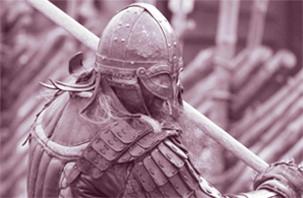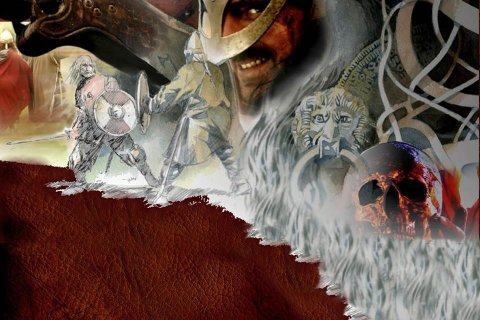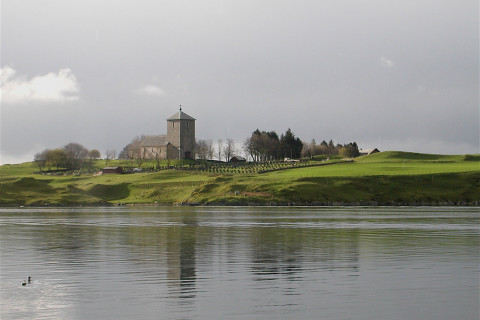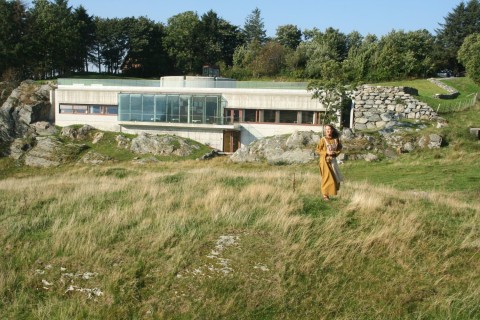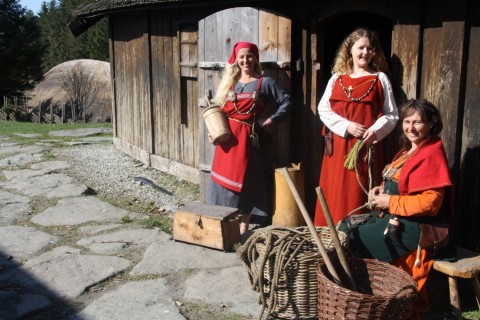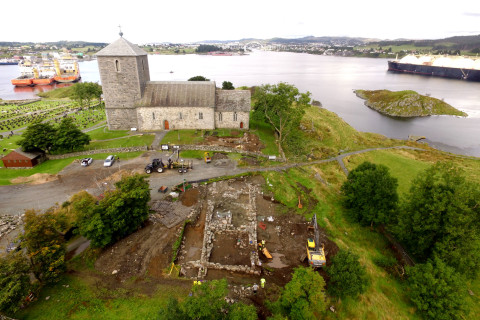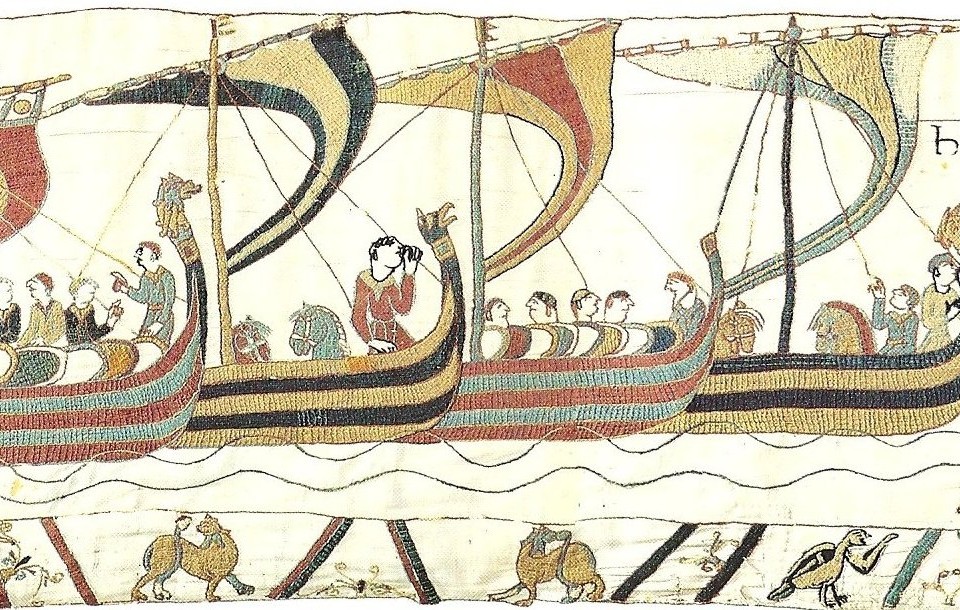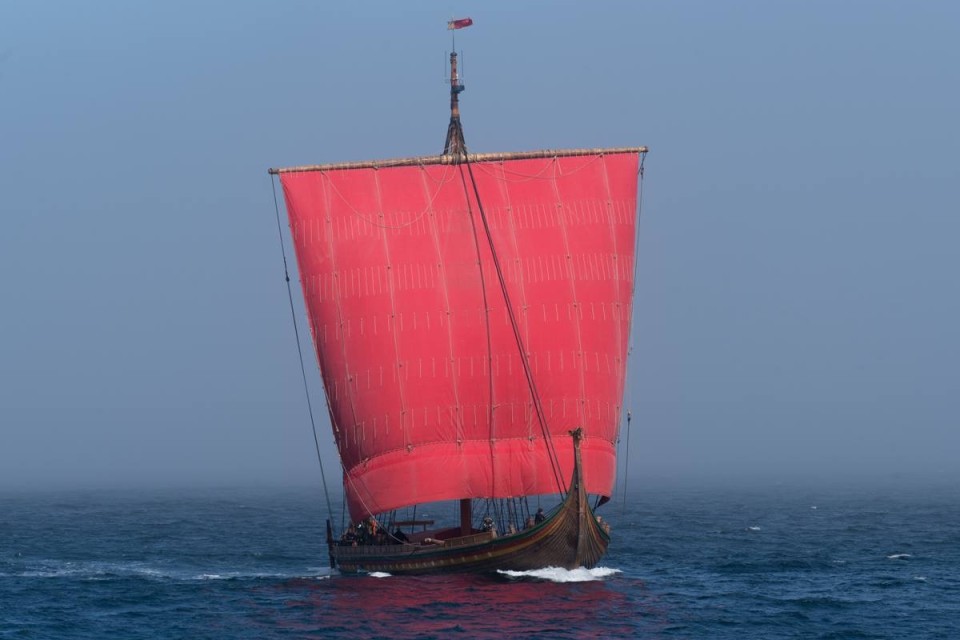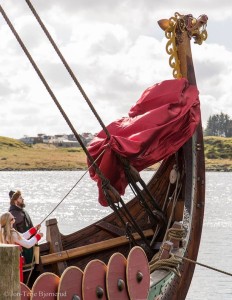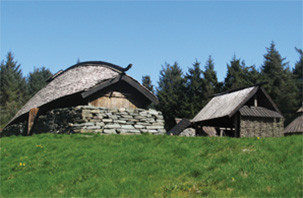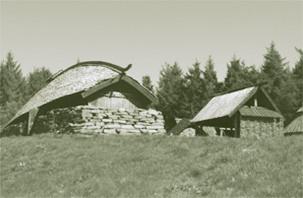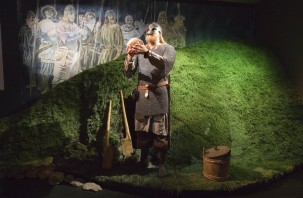Dragonships
Tekst Marit Synnøve Vea

Five animal heads were found in the Oseberg grave, but none of them belonged to the ship. Probably the figures were used in religious processions. However, these beautiful animal heads can give us an indication of how the dragon heads that adorned the Viking ships might have looked like.(Photo: Museum of Cultural History, University of Oslo, Norway)
DRAGON = DRAKE (ON dreki – m.pl. drekar)
Dragonships were large longships that had carved heads of dragons and other magical beings mounted on their stem. They were ships for chieftains and kings. The ship’s dragonhead was a visual message about the owner’s status.
His dragon with her sails of blue,
All bright and brilliant to the view,
High hoisted on the yard arms wide,
Carries great Canute o’er the tide.
Brave is the royal progress — fast
The proud ship’s keel obeys the mast,
Dashes through foam, and gains the land,
Raising a surge on Limfjord’s strand. (The Song of Canute, Saga of St. Olaf)
THE TERM DRAGON/DRAKE COULD BE USED FOR SEVERAL TYPES OF SHIPS
Dragons were large longships, from 25 sections an upwards. The term dragon (dreki) could be used both for the ship types called “skeid” and for the ones called “busse”. It was the occurrence of a dragonhead on the prow that decided whether a ship could be called a dreki.
The word dreki for a ship derives from the practice of placing carved dragonheads on ships, and is part of a group of words from the same semantic field used by poets of such ships, but there is no evidence that it was a tecnical term for any particular type of ship. (Judith Jesch, Ships and men in the late Viking Age, 2001).
The term of this first class of great ships (ON stórskip) were in the oldest time dragon, later, others as well. It is very likely that the dragon Harald Fairhair built on the west coast of Norway was a ship of 30 rooms. I.e that the development towards larger ships than the Gokstad ship, at least on the West Coast of Norway, has taken place long before the 900. (Shetelig & Brøgger: Vikingeskipene, 1950)
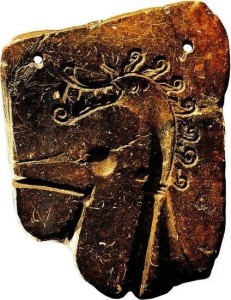
A slate mold for metal jewelry.(Photo Gyldendals åbne encyklopedi)
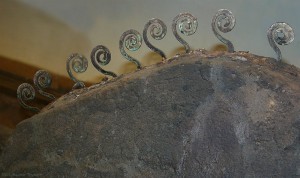
Prow ornament from the Ladebyship. ( Photo Wikimedia commons, Malene Thyssen)
THE DRAGONHEAD (ON drekahofud)
The dragonhead should scare away enemies. It also had magical functions: It would provide protection for ships and crew – and it should ward off evil spirits both on land and sea. The Icelandic law code Grágás says that the dragonhead should be taken off the ship when the Vikings returned to their homestead, not to intimidate the spirits of their native land. (Grágás was used from about 930 and written down about 1117)
The dragonhead made it easy to recognize a certain ship. It clearly shows who the leader is and where the leader is in battle. The symbolic function of the dragonhead is enhanced by the fact that ships often were named after the magical animal that graced it’s prow.
The dragon – also called serpent (ON ormr) – (perhaps modeled after the Midgard Serpent) was a primary motive for the royal longships, but also other magical beings could be used as dragonheads on some ships. When Christianity was introduced, Christian symbols and ship names eventually replaced the magical role former played by old Norse beings.
Sagas and skaldic poems tell many stories of dragonships with beautifully carved fabled animals in the stem and a tail at the stern. Some ships had dragonheads both on stem and stern. There are also old depictions of dragonheads. In the archaeological material however, there is not preserved any dragonheads that we know have adorned a ship.
A curly mane made of iron remains from the ship burial in Ladby, Denmark (10th century), can give some indications of how a ship’s dragonhead could look like. These iron curls probably decorated a wooden dragonhead mounted on the stem. The dragonhead is gone, but we can get an impression of how it might have been, by looking at a mold for metal jewelry from Birka, Sweden.

A wind vane from Söderala (Photo: Wikimedia commons)
WIND WANE ( ON veðrviti)
In Scandinavia we have finds of eight metal banners or “wind-vanes” from the period 1000 to 1300, most made of gilded bronze. These wind vanes were used as prow-ornaments on Viking ships. Later they were re-used as wind-vanes on church spires. They served as the ship owner’s mark, and perhaps these wind wanes on the stem of a ship had the same function as dragonheads.
THE LONG SERPANT (ORMEN LANGE)
The Norse sagas prise the large, solid warships above all other ships. The most legendary of them all is the Long Serpent which was built by king Olaf Tryggvason in 999. King Olaf got the idea to build this ship in Northern Norway: He stole a sturdy dragonship from Raud den Ramme in Hålogaland, after having killed the ship owner. It may seem like it was in Northern Norway these solid and strong ships were first developed:
“The ship was both long and broad and high-sided, and strongly timbered. (..) The ship was a dragon, built after the one the king had captured in Halogaland; but this ship was far larger, and more carefully put together in all her parts. The king called this ship the long Serpent, and the other the Short Serpent. The Long Serpent had thirty-four benches for rowers. The head and the arched tail were both gilt, and the bulwarks were as high as in sea-going ships. This ship was the best and most costly ship ever made in Norway.” (The saga of Olaf Tryggvasons).
The Long Serpent – a “busse” or a “skeid”?
The sagas describe the Long Serpent as a dragonship where the qualities of the sea-going sailing ships are combined with the warships need for oars and rowers…“the bulwarks were as high as in sea-going ships.”
The large, solid ship Long Serpent was neither the fastest sailor nor the best rowing ship in the King’s fleet. Still, the saga says that: “This ship was the best and most costly ship ever made in Norway”. From the descriptions in the sagas, it seems that the Long Serpent was a “busse”, but in one skaldic poem it is called a “skeid”.

Saga of Olaf Tryggvason “Eiriks men board the Long Serpent in the battle of Svolder.” (Ill. Halfdan Egedius)
The size of the Long Serpent
The Long Serpent had 34 benches for rowers, i.e. 34 sections, 68 half-sections and 68 oars. The chronicler Snorri Sturlason tells that: “In every half-section were eight men, and each and all chosen men; and in the fore-hold were thirty men.” According to Snorri, the Long Serpent had a crew of 574 men.”
It is estimated that the Long Serpent was between 47 – 48m long. Some even say that the ship was up to 57m long, depending on the alen (cubit) measurement that was used.
DRAGON HEADS AND NAMES OF VIKING SKIPS. SOME EXAMPLES
Harald Fairhair had a ship called Draken – The Dragon- . It had a serpent mounted on the stem and a tail in the stern.
Olav Tryggvason had a ship called Tranen – The Crane – probably because the ship looked like a bird with long neck because it was high in stem and stern.
St. Olaf had a ship called Visund – The bison. The ship had a bull’s head adorned with gold in the stem and in the stern a tail.
St. Olaf also had a ship called Karlshovden – Carl’s head- : “Olaf himself had a ship called the Carl’s Head, on the bow of which a king’s head was carved out, and he himself had carved it. This head was used long after in Norway on ships which kings steered themselves” (Saga of St. Olaf).
Earl Erik had a ship called Barden, which means “the bearded one” – because it had a carved head of the god Tor in the prow. The head of Tor was later replaced with a cross.
SOME DRAGON SHIPS KNOWN FROM THE SAGAS
Olaf Tryggvason confiscates Raud’s ship called Serpent
“Then the king took the dragonship which Raud had owned, and steered it himself; for it was a much larger and handsomer vessel than the Crane.
In front it had a dragon’s head, and aft a crook, which turned up, and ended with the figure of the dragon’s tail. The carved work on each side of the stem and stern was gilded. This ship the king called the Serpent. When the sails were hoisted they represented, as it were, the dragon’s wings; and the ship was the handsomest in all Norway.” (Saga of Olaf Tryggvason)
Earl Haakon’s ship
Earl Haakon had a dragonship of 40 sections.
Canute the Great’s dragon ship of 60 sections
The Danish King Canute the Great had a dragonship of 60 sections. This is the largest Viking ship mentioned in the sagas.
“Canute the Great was at last ready with his fleet, and left the land; and a vast number of men he had, and ships frightfully large. He himself had a dragon-ship, so large that it had sixty banks of rowers, and the head was gilt all over. Earl Hakon had another dragon of forty banks, and it also had a gilt figure-head. The sails of both were in stripes of blue, red, and green, and the vessels were painted all above the water-stroke; and all that belonged to their equipment was most splendid.” (Saga of St. Olaf)
Harald Hardrada’s ship Ormen
The prow of the ship had a gilded dragonhead and the stern a hook. This ship, which Snorri calles a busse, had 35 sections.
“King Harald remained all winter at Nidaros (A.D. 1062) and had a vessel built out upon the strand, and it was a buss. The ship was built of the same size as the Long Serpent, and every part of her was finished with the greatest care. On the stem was a dragon-head, and on the stern a dragon-tail, and the sides of the bows of the ship were gilt. The vessel was of thirty-five rowers benches, and was large for that size, and was remarkably handsome; for the king had everything belonging to the ship’s equipment of the best, both sails and rigging, anchors and cables.” (Saga of Harald Hardrade)
Ca 1060 he calls out the levy. He mounts the dragon head on the ship before they leave Nidaros. Thiodolf, the skald, sang about this:
It was upon a Saturday,
Ship-tilts were struck and stowed away,
And past the town our dragon glides,
That girls might see our glancing sides.
Out from the Nid brave Harald steers;
Westward at first the dragon veers;
Our lads together down with oars,
The splash is echoed round the shores.
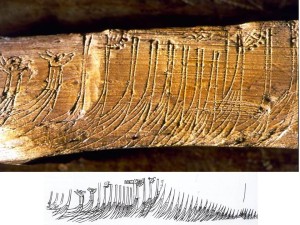
Carving found in Bergen
The carving probably shows Haakon Haakonason’s fleet as Earl Skule of Trøndelag saw it in 1233 when he was summoned to Bergen. We can see two vessels with dragonheads, and several with wind-vanes that adorn the prow.
SOME OF HAAKON HAAKONSON’S MANY GREATSHIPS
Kristsuden (Christ-sud)
Kristsuden was built around 1260. Kristsuden was a ship of 37 section, ie 74 oars. This is supposed to be the largest ship built in Norway. The saga indicates that the large size made the ship less seaworthy. Kristsuden is supposed to have been around 52m long.
“It was built entirely of oak, and contained thirty-seven banks of oars. It was ornamented with heads and necks of dragons beautifully overlaid with gold.He had also many other well-appointed ships.“(Saga of Haakon Haakonsson)
Draken (the Dragon)
King Haakon built several ships of the class “25-sections”. One of them he simply called Draken. This ship gained a great reputation as a very seaworthy vessel. When the king sailed it to eastern Norway in 1226, it was known as one of the best sailors in the king’s fleet. It sailed away from all the other ships, and also had a reputation as a very beautiful ship.
Mariasuden (Maria-sud)
It was a dragonship of 30 sections, and it was the most beautiful ship ever built in Norway. The dragonhead and the tail was gilded, the sail was decorated with beautiful pictures. Mariasuden was about 42m long.
Kross-suden (Cross-sud)
Krossuden was a ship of 35 sections. The ship was very high-sided. It was 9 alen (cubits) (almost 5 m)from the gunwale to the sea
Olavssuden II (Olav-sud)
Olavssuden was a large and unusually beautiful ship of 29 sections.
————
FROM FOREIGN SOURCES
About Sweyn Forkbeard’s (Sven Tveskjegg) fleet.
(The fleet raids England to revenge the massacre of the Danes)
This army embarked in tall ships, each of which had a distinctive badge designating its commander. Some had at the prow figures of lions, bulls, dolphins, men, in gilt copper; others bore at their mast-head birds spreading their wings and turning with the wind; the sides of the ships were painted in various colours, and the bucklers of polished steel were suspended along them in rows. (…) (Emmæ reginæ Encomion, apud Script. rer. Normann. p. 168. Saxon Chron)
About the use of standards
On landing in England, the Danes, falling into battalions, unfurled a mystic standard, termed by them the Raven.
It was a flag of white silk, in the centre of which appeared the black figure of a raven, with open beak and outspread wings; three of king Swen’s sisters had worked it in one night, accompanying their labour with magic songs and gestures. (Emmæ Encom., p. 170.)
Back

